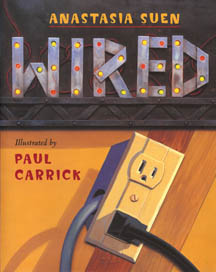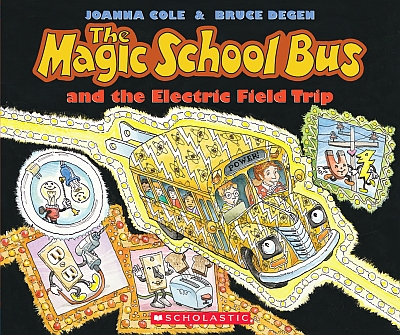Introduction
Chosen books could be used to help students investigate and understand the characteristics of electricity, such as conductors and electricity, basic circuits, static electricity, transformation of electrical energy into light, heat and mechanical energy, electromagnets, and historical contributions in understanding electricity. Selected books are aimed for elementary school students but for different grade levels.
The short sections in “Electricity” make the book useful for different levels and for multiple activities and lessons. “Switch On, Switch Off” is perfect for use in young classrooms. The text is extremely kid-friendly, leaving out any elaborate, overwhelming explanations. “Flick a Switch” will help lower elementary students picture how electricity travels from power plants to their homes. Fourth and fifth grade physical science lessons can incorporate this book into electricity units about conductors, insulators, electromagnetism, and historical figures who contributed to our understanding and use of electrical power. “Wired” is a great resource to help upper elementary school students learn about an important part of physical science; electricity, because it describes in great detail how electricity is created and how it is transported to different places, while still being fun with its illustrations and catchy subtitles. “The Magic School Bus and the Electric Field Trip” can be used to cover a wide range of science topics in regards to energy in grades 3-5. The book covers information on different sources of energy, magnetism, electrons and atoms, and explains the science behind how many things work.
“Electricity”

Electricity, a DK Eyewitness book written and illustrated by Steve Parker, is a great introduction to electricity. The book is written in short sections with one topic per two pages spread. There are lots of pictures which makes the book very visually interesting. Each section discusses the science behind electricity and includes information about important historical scientists. Topics covered include Circuits and Conductors, Electromagnets, Discoveries using electricity, Electricity in the home, and more.
Students can learn more about electric circuits with the interactive Blobz Guide to Electric Circuits.
Teachers can explore static electricity with this experiment.
“Switch On, Switch Off”

Light switches are everywhere! They are in every house: in the kitchen, the bedroom, the office, the bathroom…but are they really magic? When it’s time for bed and mom yells “lights out.” is it truly magic within that switch that allows the room to get dark? Switch On, Switch Off, written by Melvin Berger and illustrated by Carolyn Crolll, is an excellent resource for your children to begin exploring the magic within the light switch, or what is better know as electricity. The story begins just this way, with a child heading to bed, curious as to how his light switch operates. This commences the lesson where Berger youthfully explains circuits, generators, light bulbs, and plugs, thus demonstrating how electricity is produced and even used. With the help of Croll’s easy to understand illustrations, children can not only read about electricity, but they can see pictures that enforce how the process works. The author even offers a live experiment that children can do to create their own electricity using just a magnet, compass and a piece of wire.
Electricity Circuits and Conductors is a great interactive tool for children to experiment with electricity conductors.
Electricity and Magnetism is a help site for children to utilize if they have questions or need clarification about the concepts. Within specific sections under various topics are games, activities,histories, and helpful hints.
Electricity Teaching Resources is a site to be used by teachers wishing to explore electiricty with students. The site contains, activites, games, teaching strategies, physical science links, quizzes, tests and more!
“Flick a Switch”

You flick a switch to turn on a light or to turn on your computer. You know electricity makes it happen; but, where does the electricity come from? The path electricity takes from the power plant to homes and businesses is described in Flick a Switch: How Electricity Gets to Your Home written by Barbara Seuling with illustrations by Nancy Tobin. This book uses straight-forward language and bright, kid-friendly drawings to help children understand the science and technology behind generating electricity. Simple activities that use everyday items to demonstrate electrical circuits are included.
When you hear the name Thomas Edison you think light bulb. When you hear Ben Franklin you think electricity. But what do you think when you hear Michael Faraday? Learn more about Michael Faraday, whose work with electromagnetism made the generators in power plants possible.
Benjamin Franklin was an inventor. This website helps students understand Benjamin Franklin’s contributions. Drawings were done by other students and they all wrote a sentence about who Ben Franklin was. This a way for students to learn from their peers as well as to see other points of view on Ben Franklin.
“Wired”

Wired, written by Anastasia Suen and illustrated by Paul Carrick, is a physical science book for students related to electricity. The book starts out by explaining the importance of electrons and describing how electricity is made at the power plant. It goes on to explain the different types of vehicles used to transport electricity to surrounding areas and cities (transformer towers, feeder line, secondary wires, ect.) As one reads the book, he or she can see that the author is explaining the process of how electricity is created and moved to other places step by step. The pictures start out showing the power plant, and end up illustrating the ways electricity is used around the house in lamps, computers, breakers, and more. The book ends with a few tips for children on how to “Be Smarter About Power!” and lists some websites and other book resources where children can find more about electricity.
“The Magic School Bus and the Electric Field Trip”

The Magic School Bus and the Electric Field Trip, takes Ms. Frizzle’s students through the concepts of electricity in an exciting field trip. The field trip begins when the power goes out at school and Ms. Frizzle takes the students on a journey to find out the problem. Power lines are down in the streets and the students begin their exploration at a power plant. The students travel through steam and a turbine and enter into power lines. From there they travel to the library, explore inside a light bulb, continue on to a restaurant and Phoebe’s house, and then return back to the school. Throughout the storm many topic of energy are covered such as; how to make an electromagnet, different sources of energy, how a motor works, how a TV works, how a switch works, how steam works, and how to make a mini-power plant. It also discusses electrons and atoms.
The Florida Project Learning Three has a great resources for teachers to use with The Magic School Bus and the Electric Filed Trip on activity. The packet includes discussion questions, vocabulary words, vocabulary practice, worksheets, comprehension questions, sequencing practice worksheets, and writing exercises.
Hotchalk has a good three week unit for students to learn about electricity. Topics include: renewable energy, wind turbines, testing electric currents, and energy resources.
